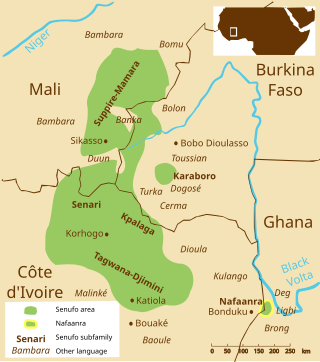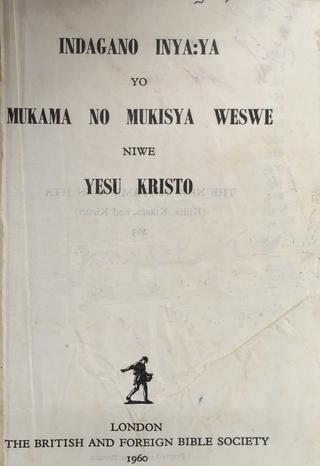Related Research Articles
Sango is the primary language spoken in the Central African Republic and also the co-official language of the country. It is used as a lingua franca across the country and had 450,000 native speakers in 1988. It also has 1.6 million second language speakers.

Sandawe is a language spoken by about 60,000 Sandawe people in the Dodoma Region of Tanzania. Sandawe's use of click consonants, a rare feature shared with only two other languages of East Africa – Hadza and Dahalo, had been the basis of its classification as a member of the defunct Khoisan family of Southern Africa since Albert Drexel in the 1920s. Recent investigations however suggest that Sandawe may be related to the Khoe family regardless of the validity of Khoisan as a whole. A discussion of Sandawe's linguistic classification can be found in Sands (1998).

Nafaanra, also known as Nafanan or Nafana, is a Senufo language spoken in northwest Ghana, along the border with Ivory Coast, east of Bondoukou. It is spoken by approximately 90,000 people. Its speakers call themselves Nafana, but others call them Banda or Mfantera. Like other Senufo languages, Nafaanra is a tonal language. It is somewhat of an outlier in the Senufo language group, with the geographically-closest relatives, the Southern Senufo Tagwana–Djimini languages, approximately 200 kilometres (120 mi) to the west, on the other side of Comoé National Park.

The Mazatecan languages are a group of closely related indigenous languages spoken by some 200,000 people in the area known as the Sierra Mazateca, which is in the northern part of the state of Oaxaca in southern Mexico, as well as in adjacent areas of the states of Puebla and Veracruz.
Dinka is a Nilotic dialect cluster spoken by the Dinka people, a major ethnic group of South Sudan. There are several main varieties, such as Padang, Rek, Agaar, Ciec, Apaak, Aliep, Bor, Hol, Nyarweng, Twic East and Twic Mayardit, which are distinct enough to require separate literary standards. Jaang, Jieng or Muonyjieng is used as a general term to cover all Dinka languages. Recently Akutmɛ̈t Latueŋ Thuɔŋjäŋ has proposed a unified written grammar of Dinka.
Kuman is a language of Chimbu Province, Papua New Guinea. In 1994, it was estimated that 80,000 people spoke Kuman, 10,000 of them monolinguals; in the 2000 census, 115,000 were reported, with few monolinguals. Ethnologue also reported 70,000 second language speakers in 2021.
The Manenguba languages, also known as the Mbo cluster, are a group of closely related Bantu languages spoken on and around the Manenguba mountain range in south-western Cameroon.
Gwere, or Lugwere, is the language spoken by the Gwere people (Bagwere), a Bantu people found in the eastern part of Uganda. It has a close dialectical resemblance to Soga and Ganda, which neighbour the Gwere.
The Kom language is the language spoken by the Kom people in Northwest Province in Cameroon. It is classified as a Central Ring language of the Grassfields, Southern Bantoid languages in the Niger-Congo language family. Kom is a tonal language with three tones.
Bari is the Nilotic language of the Karo people, spoken over large areas of Central Equatoria state in South Sudan, across the northwest corner of Uganda, and into the Democratic Republic of Congo.
Iau or Turu is a Lakes Plain language of West Papua, Indonesia, spoken by about 2,100 people, native speakers of this language are the Turu people (Iau). Most speakers are monolingual, and their number is growing. Other peoples in the western Lakes Plain area speak basic Iau. Iau is heavily tonal, with 11 tones on nouns and 19 simple and compound tones on verbs.
Zaghawa is a Nilo-Saharan language spoken by the Zaghawa people of east-central Chad and northwestern Sudan (Darfur). The people who speak this language call it Beria, from Beri, the endonym of the Zaghawa people, and a, Zaghawa for "mouth". It has been estimated that there are about 447,400 native speakers of the Zaghawa language, who primarily live in Chad and the Darfur region of Sudan. It is also spoken by a smaller number of speakers in Libya.
Sheko is an Omotic language of the Afro-Asiatic language family spoken in the area between Tepi and Mizan Teferi in western Ethiopia, in the Sheko district in the Bench Maji Zone. The 2007 census lists 38,911 speakers; the 1998 census listed 23,785 speakers, with 13,611 identified as monolinguals.
The Bongo–Bagirmi or Sara–Bongo–Bagirmi (SBB) languages are the major branch of the Central Sudanic language family with about forty languages. Principal groups include Bagirmi languages such as Naba and the Sara languages. They are spoken across CAR, Chad, South Sudan, and adjacent countries.
The Lopit language is an Eastern Nilotic language spoken by around 117,000 people in Eastern Equatoria State, South Sudan. Lopit is part of the Lotuko-Teso subfamily and is related to Lotuko, Turkana and Maasai. Lopit is a VSO language and has a complex tonal system.
Midob is a Nubian language spoken by the Midob people of North Darfur region of Sudan. As a Nubian language, it is part of the wider Nilo-Saharan language family.

Jita is a Bantu language of Tanzania, spoken on the southeastern shore of Lake Victoria/Nyanza and on the island of Ukerewe.
´Bëlï, or Jur Beli, is a Central Sudanic language spoken by the Beli and Sopi people of South Sudan. The Beli people are mainly found in South Sudan, a region southeast of Rumbek. The language is considered as endangered, and it is mostly spoken by the older generation.
Luang, also known as Literi Lagona, is an Austronesian language spoken in the Leti Islands and the Babar Islands in Maluku, Indonesia. It is closely related to the neighboring Leti language, with 89% shared basic vocabulary.
Mixtepec Mixtec is a Mixtec language that is spoken in the lower Mixteca region. Mixtec language is largely spoken in the area of San Juan Mixtepec, district of Juxtlahuaca, state of Oaxaca. However, the language is also spoken in other areas including Tlaxiaco, San Quintín Baja California, Santa María California, and Oregon. In 2004, it was reported that approximately 12,000 people spoke the Mixtepec Mixtec language. While most speakers of the language refer to it as 'sa'an ntavi' meaning 'language of the poor' or 'poor people's language,' others refer to it as 'sa'an save' which means 'rain language.' It is not closely related to other varieties of Mixtec.
References
- ↑ Bongo at Ethnologue (27th ed., 2024)

- ↑ Moi et al. 2018a, p. 5.
- ↑ Moi et al. 2018a, p. 34.
- ↑ Moi et al. 2018b, p. 5.
- ↑ "Bongo at Numeral Systems of the World's Languages".
- ↑ Evans-Pritchard, E. E. (1929). "The Bongo". Sudan Notes and Records. pp. 1–62.
- ↑ Evans-Pritchard, E. E. (1937). "The non-Dinka peoples of the Amadi and Rumbek Districts". Sudan Notes and Records. pp. 156–158.
- ↑ Kilpatrick, Eileen (1985). "Bongo Phonology". Occasional Papers in the Study of Sudanese Languages. 4: 1–62.